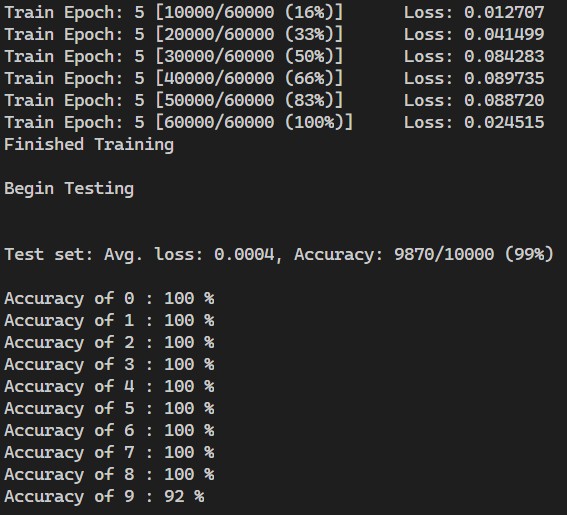1
2
3
4
5
6
7
8
9
10
11
12
13
14
15
16
17
18
19
20
21
22
23
24
25
26
27
28
29
30
31
32
33
34
35
36
37
38
39
40
41
42
43
44
45
46
47
48
49
50
51
52
53
54
55
56
57
58
59
60
61
62
63
64
65
66
67
68
69
70
71
72
73
74
75
76
77
78
79
80
81
82
83
84
85
86
87
88
89
90
91
92
93
94
95
96
97
98
99
100
101
102
103
104
105
106
107
108
109
110
111
112
113
114
115
116
117
118
119
120
121
122
123
124
125
126
127
128
129
130
131
132
133
134
135
136
137
138
139
140
141
142
143
144
145
146
147
148
149
150
151
152
153
154
155
156
157
158
159
160
161
162
163
164
165
166
167
168
169
170
171
172
173
174
175
176
177
178
179
180
181
182
183
184
185
186
187
188
189
| import torch
import torchvision
import torchvision.transforms as transforms
import matplotlib.pyplot as plt
import torch.nn as nn
import torch.nn.functional as F
import torch.optim as optim
from torch.utils.data import DataLoader
from torch.autograd import Variable
EPOCH = 5
BATCH_SIZE = 100
LR = 0.001
DEVICE = torch.device('cuda' if torch.cuda.is_available() else 'cpu')
'''
transform=torchvision.transforms.Compose([
torchvision.transforms.ToTensor(),
torchvision.transforms.Normalize(
(0.1307,), (0.3081,))
])
'''
train_data = torchvision.datasets.MNIST(
root='./data/',
train=True,
transform=transforms.ToTensor(),
download=False
)
test_data = torchvision.datasets.MNIST(
root='./data/',
train=False,
transform=transforms.ToTensor(),
download=False
)
train_loader = DataLoader(
dataset=train_data,
batch_size=BATCH_SIZE,
shuffle=True
)
test_loader = DataLoader(
dataset=test_data,
batch_size=BATCH_SIZE,
shuffle=False
)
'''
# 查看数据(可视化数据)
def datashow(train_loader):
images, label = next(iter(train_loader))
images_example = torchvision.utils.make_grid(images)
images_example = images_example.numpy().transpose(1,2,0) # 将图像的通道值置换到最后的维度,符合图像的格式
mean = [0.5,0.5,0.5]
std = [0.5,0.5,0.5]
images_example = images_example * std + mean
print(labels)
plt.imshow(images_example )
plt.show()
'''
class Net(nn.Module):
def __init__(self):
super(Net, self).__init__()
self.conv1 = nn.Conv2d(1, 6, 3, 1, 2)
self.conv2 = nn.Conv2d(6, 16, 5)
self.fc1 = nn.Linear(16 * 5 * 5, 120)
self.fc2 = nn.Linear(120, 84)
self.fc3 = nn.Linear(84, 10)
def forward(self, x):
x = F.max_pool2d(F.relu(self.conv1(x)), (2, 2))
x = F.max_pool2d(F.relu(self.conv2(x)), 2)
x = x.view(-1, self.num_flat_features(x))
x = F.relu(self.fc1(x))
x = F.relu(self.fc2(x))
x = self.fc3(x)
return x
def num_flat_features(self, x):
size = x.size()[1:]
num_features = 1
for s in size:
num_features *= s
return num_features
net = Net().to(device=DEVICE)
criterion = nn.CrossEntropyLoss()
optimizer = optim.Adam(net.parameters(), lr=LR)
train_counter = []
train_losses = []
train_accs = []
test_losses = []
test_counter = [i*len(train_loader.dataset) for i in range(EPOCH)]
def train(epoch):
for i, data in enumerate(train_loader, 0):
inputs, labels = data
inputs, labels = Variable(inputs).cuda(), Variable(labels).cuda()
optimizer.zero_grad()
outputs = net(inputs)
loss = criterion(outputs, labels)
loss.backward()
optimizer.step()
if i % 100 == 99:
print('Train Epoch: {} [{}/{} ({:.0f}%)]\tLoss: {:.6f}'.format(
epoch, (i+1) * len(inputs), len(train_loader.dataset),
100. * i / len(train_loader), loss.item()))
train_losses.append(loss.item())
train_counter.append((i*BATCH_SIZE) + ((epoch-1)*len(train_loader.dataset)))
correct = 0
total = 0
_, predicted = torch.max(outputs.data, 1)
total = labels.size(0)
correct = (predicted == labels).sum().item()
train_accs.append(100*correct/total)
print('Finished Training')
def test():
print('\n'+"Begin Testing"+'\n')
net.eval()
correct = 0
total = 0
test_loss = 0
with torch.no_grad():
for data in test_loader:
images, labels = data
images, labels = Variable(images).cuda(), Variable(labels).cuda()
outputs = net(images)
loss = criterion(outputs, labels)
test_loss += loss.item()
_, predicted = torch.max(outputs.data, 1)
total += labels.size(0)
correct += (predicted == labels).sum().item()
test_loss /= total
test_losses.append(test_loss)
print('Test set: Avg. loss: {:.4f}, Accuracy: {}/{} ({:.0f}%)\n'.format(
test_loss, correct, total,
100. * correct / total))
class_correct = list(0. for i in range(10))
class_total = list(0. for i in range(10))
with torch.no_grad():
for data in test_loader:
images, labels = data
images, labels = Variable(images).cuda(), Variable(labels).cuda()
outputs = net(images)
_, predicted = torch.max(outputs, 1)
c = (predicted == labels).squeeze()
for i in range(4):
label = labels[i]
class_correct[label] += c[i].item()
class_total[label] += 1
for i in range(10):
print('Accuracy of %s : %2d %%' % (i, 100 * class_correct[i] / class_total[i]))
for epoch in range(1, EPOCH + 1):
train(epoch)
test()
fig = plt.figure()
plt.plot(train_counter, train_losses, color='blue')
plt.scatter(test_counter, test_losses, color='red')
plt.legend(['Train Loss', 'Test Loss'], loc='upper right')
plt.xlabel('epoch')
plt.ylabel('loss')
plt.show()
|
